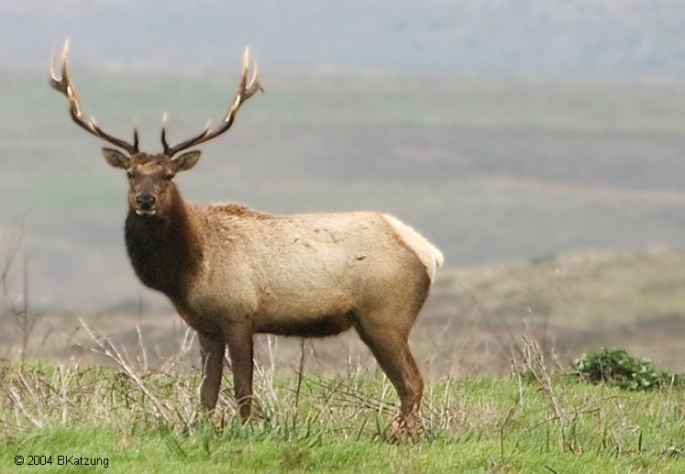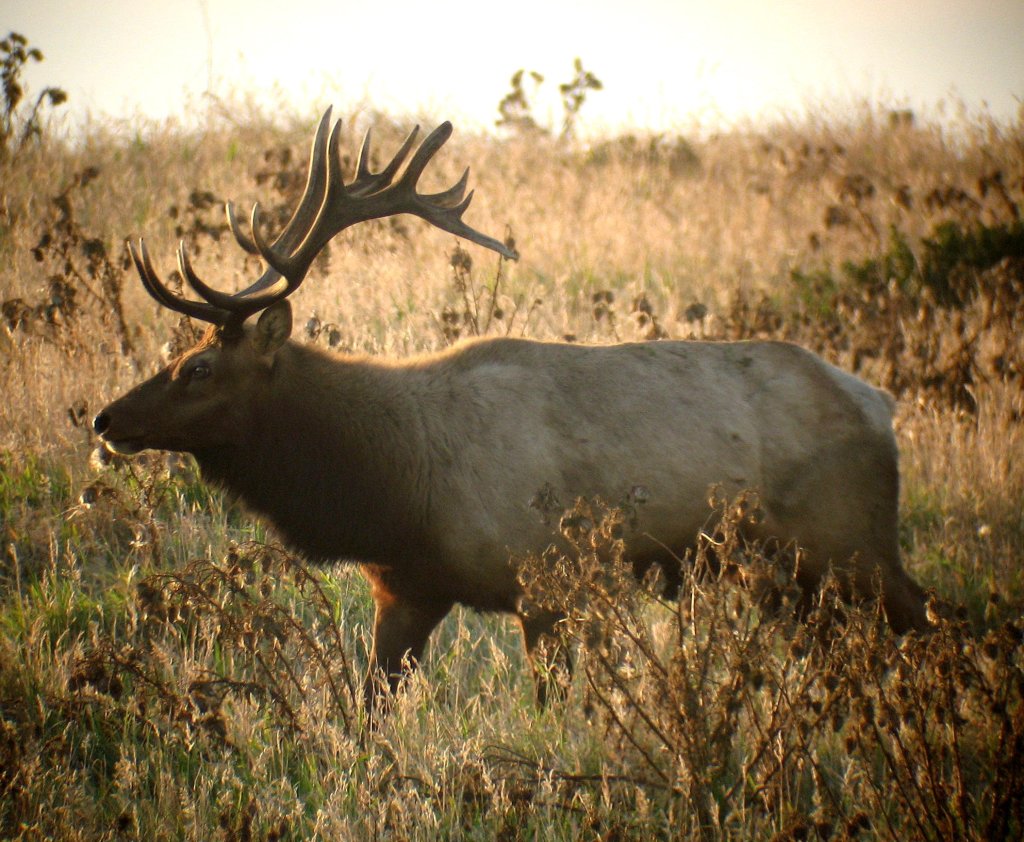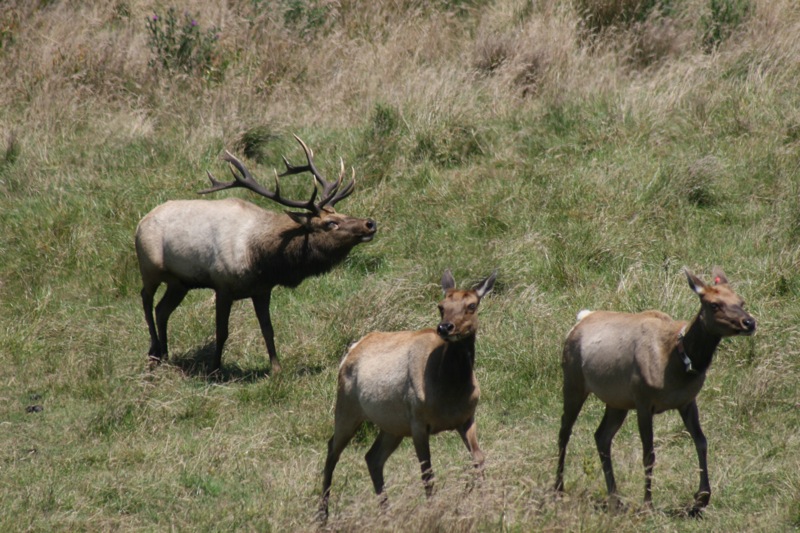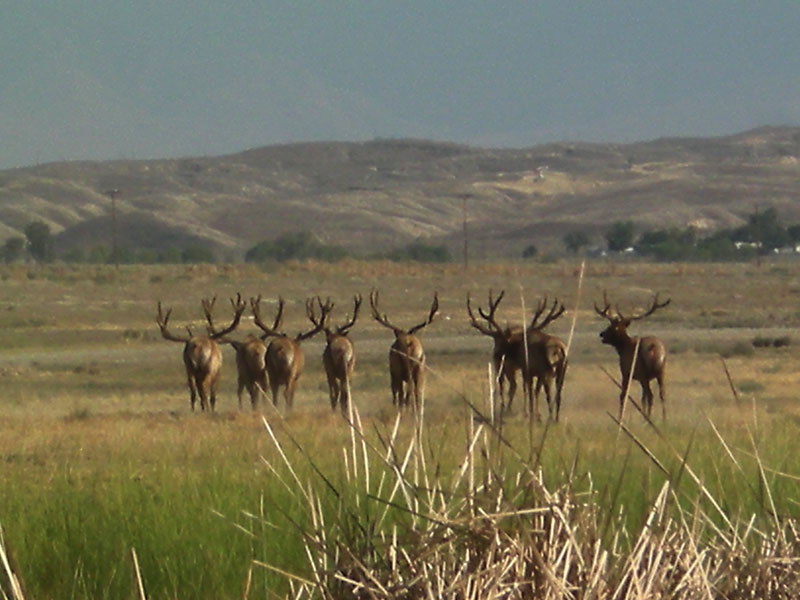Cervus elaphus nannodes

Tule elk bull. Photo by Bert Katzung.
Endemic to California, Tule Elk are not found anywhere else in the world. Historically, as many as 500,000 Tule Elk roamed California. Centuries ago, American Indians used their antlers and bones for tools, and made skins out of their hides. However, when European settlers started pouring into California in the 1800s, they brought the Tule Elk to the brink of extinction. By 1870, the Tule Elk was believed to be entirely extinct as a result of hunting and the expansion of agricultural lands into elk habitat. However, in 1874 ranch workers discovered a small herd of Tule Elk near Bakersfield, CA. Henry Miller, the owner of the land on which they were discovered, decided to dedicate his land to the protection of these elk and their population began to rebound.
By 1905, the population of this herd had reached 140 individuals and some were captured to be moved to other areas of California. In 1971, state Senate Bill 722 was passed in California protecting Tule Elk from hunters until their population reached 2,000 individuals. In 1976, another law was passed that required the federal government to set aside lands for preserving Tule Elk. By 1989, the Tule Elk population had reached 2,000 and by 1998 the population had reached 3,000. Today there are nearly 4,000 Tule Elk throughout California, signifying the success of conservation efforts which helped bring the population back from an estimated 28 surviving individuals.

Photo by K. Schneider.
Of the 22 Tule Elk herds in California, 3 reside on and adjacent to the Los Padres National Forest. One of these herds, the Pozo-La Panza herd, is the largest herd in the state, containing around 600 animals. This herd ranges from Pine Canyon in the La Panza Range east to the Carrizo Plain. The other two of these herds inhabit Fort Hunter Liggett in southern Monterey County and Camp Roberts Military Base near the Salinas River. Smaller herds also reside within the Bitter Creek National Wildlife Refuge and the Wind Wolves Preserve. Go check them out!
Habitat and Life History
Six species of elk historically inhabited North America, of which four remain: Roosevelt, Manitoban, Rocky Mountain, and Tule. Tule Elk are the smallest of all North American elk species with full grown males weighing about 500 pounds and females about 400 pounds. Tule Elk reach reproductive maturity after about two years. While most females (cows) reproduce in their lifetime, only about half of the males (bulls) will have the chance to reproduce, with most of the reproduction being carried on by 10% of the bulls. The reproductive season of the Tule Elk is known as the rutting season. During this time, bulls intimidate each other by bellowing, displaying their antlers, and sometimes by fighting. Dominant bulls gather together a group of up to 30 cows, called a harem, with whom they hope to mate. During the rutting season, the bull mates with as many cows within his harem as possible while defending them from other bulls.

Photo by Jill Goodell.
Tule Elk live in open, brushy habitats on gently sloping hills, characteristics shared by many areas of the Los Padres National Forest. These areas provide good opportunities for forage and also provide cover for newborn calves who hide amongst the brush for the first 18-20 days after being born. Tule Elk are grazers and browsers and consume grasses, herbs, woody shrubs, and trees in the areas they live. Adult males will often consume around 15 pounds of food every day!
Partially as a result of the preferred habitat of the Tule Elk, there are few predators threatening this species. Before they were eliminated from California, Grizzly Bears used to prey on Tule Elk, but now their main attackers are mountain lions, with an occasional attack on a calf by coyotes.
Threats and Conservation Issues
The major threat facing Tule Elk today is a lack of adequate habitat. It is unlikely that the population will reach its historic size of 500,000 animals due to the spread of agricultural and urban lands into the historic range of the animals however, it is important to ensure that enough suitable land remains available to the Tule Elk to support viable populations. The prime habitat that exists in and around the Los Padres National Forest, within the Carrizo Plains National Monument, and on the Bitter Creek National Wildlife Refuge must be protected to give these magnificent animals a good shot at long-term survival. At the same time, it is important to monitor the sizes of populations and keep them down to a number that can be supported by the area in which they reside. Because space is limited, a successful population may outgrow the available resources in its area and drive itself towards extinction.

Photo courtesy Flickr user Sonofabike.
Currently, the conservation of Tule Elk herds is a priority that has been written into the conservation plans for the Carrizo Plains National Monument, and the Bitter Creek National Wildlife Refuge. The objective of these plans is to provide and improve calving and foraging habitat for Tule Elk in the area. Management actions outlined in these plans include supporting efforts to monitor Tule Elk populations and their diets, habitat uses, population dynamics, and biology, maintaining and improving elk habitat, and protecting herds from vehicle collisions. Los Padres ForestWatch supports consideration for these animals within public lands management plans and will continue to push for inclusion of Tule Elk within future conservation plans drafted for the Los Padres National Forest and surrounding public lands.






